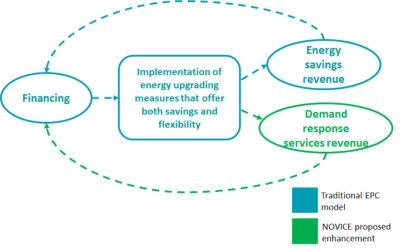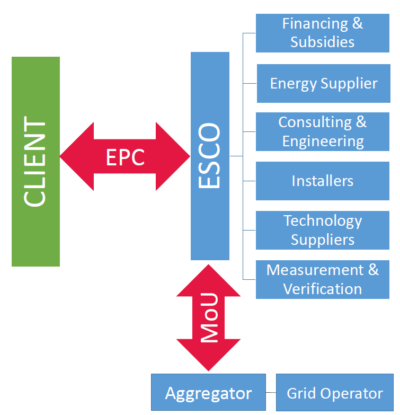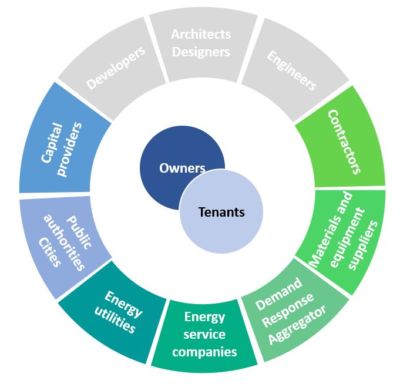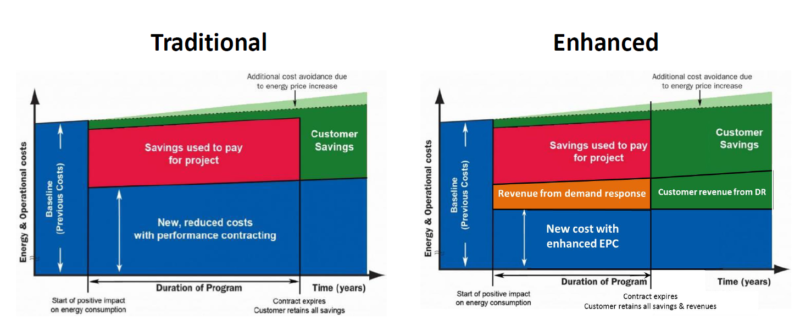Enhanced Energy Performance Contracting
Description
The Enhanced Energy Performance Contracting (EPC) model, proposed by NOVICE project, consists to generate revenues from Energy Savings, as in the classic EPC model, but also to generate revenues from Demand Response Services.
 Demand response is a way of shifting or reducing electricity usage during peak periods. Indeed, when electricity demand exceeds supply on the grid, clients’ electrical asset consumption can be adjusted by using aggregator technology. Thanks to this shift, power returns to the grid and the supply and demand balance is restored in a cost effective and green way. Also, the clients earn revenues simply for participating and being available.
Demand response is a way of shifting or reducing electricity usage during peak periods. Indeed, when electricity demand exceeds supply on the grid, clients’ electrical asset consumption can be adjusted by using aggregator technology. Thanks to this shift, power returns to the grid and the supply and demand balance is restored in a cost effective and green way. Also, the clients earn revenues simply for participating and being available.
In the Enhanced EPC model, the ESCOs remain the single point of contact for all measures but uses the services of a demand response aggregator to provide services to the grid. A Memorandum of Understanding (MoU) governs the relationship between ESCO and Aggregator.

Market readiness for Enhanced EPC is varying across European countries.
Some of them, like France or UK, have well developed or growing ESCO markets and several open DR markets with regulation that encourages aggregators to participate. Other countries (Belgium, Germany, Finland…) have either an advanced ESCO or an open DR market but strict regulations that limit the ability of aggregators to participate. Finally, some EU countries like Italy or Spain have immature ESCO and closed DR markets (or do not legally allow aggregation).
"What” (value proposition)
The Enhanced EPC model considers demand response as well as energy efficiency measures. It creates a dual revenue stream, one from energy efficiency and another from demand response. For ESCOs and aggregators, it brings access to new markets, improvement of ROI and ability to finance more projects. For Building owners, Enhanced EPC is a way to have a faster payback period, a shorter contract duration, and it increases asset value through smart building components.
"Who” (target customer)
 Aim of the model is the development and demonstration of an innovative business model for Energy Service Companies (ESCOs) that will provide energy savings to buildings and demand response (DR) services to the grid after renovating buildings or blocks of buildings.
Aim of the model is the development and demonstration of an innovative business model for Energy Service Companies (ESCOs) that will provide energy savings to buildings and demand response (DR) services to the grid after renovating buildings or blocks of buildings.
"How” (value chain, activities, resources)
The ESCOs is the single point of contact and is in charge of the implementation of energy efficiency measures and smart meter components. Aggregators support the ESCOs at the end of the value chain for the adaptation of building consumption.
components. Aggregators support the ESCOs at the end of the value chain for the adaptation of building consumption.
Enhanced EPC full-service spectrum include financing, planning, construction, energy management, risk transfer, operations, maintenance & repair.
End-consumers don’t require upfront capital as finance for the project is provided by the ESCOs or third-party finance providers, and the loan is repaid from the savings on energy bills.
Energy Savings are then guaranteed by the ESCOs, removing the operational risk from client.
"Why” (revenue model and cost structure)
The Enhanced EPC model brings the relevant stakeholders (ESCOs for the implementation of energy upgrade renovations, aggregators for facilitating the provision of demand response to the grid, financiers of energy investments and building operators and owners) together to create an innovative business model that can allow for faster repayment of energy efficiency investments combining revenue streams from both energy savings and grid services into a single offering.

